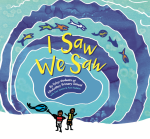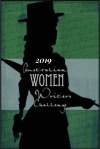Who would have thought that my little capital city of Canberra would have such a rich children’s picture book community, but over recent years I’ve been discovering just how much is going on here. So much so that I thought it might be a worthwhile topic for Brona’s AusReadingMonth.
There’s no way I can be comprehensive, so I’m going to briefly introduce ten children’s picture book creators to give a flavour. How to do this though, given picture books comprise both words and pictures, usually created by different people. We rarely know which came first, but mostly, I believe, it’s the story. So, my list here focuses on Canberra’s authors, but I will reference illustrators they have worked with. The books mentioned range from those for toddlers to primary school-aged children.
I draw heavily on Marion, the newly rebadged ACT Writers Centre, for background info on the authors.
Emma Allen
Allen was a trained early childhood speech pathologist before turning to literature. Her book The terrible suitcase, illustrated by Freya Blackwood, won the 2013 CBCA Book of the Year: Early Childhood award. It has been translated into several languages, including Japanese and Korean. Since then she has written several picture books, with her last, The great book-swapping machine, illustrated, cartoon-style, by Melbourne-based Lisa Coutts.
Nicole Godwin
Godwin is “an award-winning author with a passion for the environment, animal rights and social justice”. Her two books, Jelly-Boy and Swoop, have different illustrators. Jelly-Boy, a cautionary tale about plastic featuring a jellyfish who falls in love with a plastic bag, was illustrated by Sydney-based Christopher Nielsen. In 2020, it won the Conservation Awareness for Children Category in the Whitley Awards. Swoop was illustrated by Canberra illustrator Susannah Crispe. It speaks closely to Canberrans who, every year, brace for swooping magpie season, that is, spring! Like some other picture books I’ve read, it includes information at the end, here on magpies, which adults can share with children.
Godwin has also collaborated with Wiradjuri man Duncan Smith on We are Australians, with illustrator Jandamarra Cadd, a Yorta Yorta and Dja Dja Warung descendent.
Irma Gold
Gold is no stranger to this blog, as I’ve reviewed a wide range of her works including two of her three children’s picture books, Megumi and the bear (my review), Where the heart Is (my review) and Seree’s story. The illustrators are, respectively, New Zealand-based Craig Phillips, Susannah Crispe (again) and Sydney-born Wayne Harris. She is “passionate about childhood literacy” and is an Ambassador for the ACT Chief Minister’s Reading Challenge.
Tania McCartney
McCartney is described as “a book creator” because she has covered the whole gamut of creation from writing and illustrating to editing and design. She has won many awards, and her books have “reached the hands of children in more than 20 countries”. She is also Ambassador for the ACT Chief Minister’s Reading Challenge, and founded Kids’ Book Review and The Happy Book podcast. She has created too many books for me to list, but I did review her The Gum Family finds home, which was illustrated by Tasmanian-based Christina Booth. She is also the author/illustrator of the Plume travel series and I Heart the World.
Amelia McInerney
McInerney is a “humorous picture book author”. Her books have won various awards Her titles include The book chook, My bird, Bertie, and the internationally published Bad crab, illustrated respectively by Connah Brecon, Shane McG and Philip Bunting. Her fourth book, Who fed Zed?, is about food allergy and intolerance and is illustrated by Queensland-based graphic designer and animator, Adam Nickel.
Stephanie Owen Reeder
Reeder is the award-winning author of over 20 books for children, “ranging from picture books to historical novels”. She writes, illustrates, edits and reviews books. She received the Laurie Coping Award for Distinguished Service to Children’s Literature in the ACT in 2019 and is also an Ambassador for the ACT Chief Minister’s Reading Challenge. Again, she has written too many for me to list them all, but two of her latest books, Australia’s wild, weird, wonderful weather and Ghostie were illustrated, respectively by Tania McCartney and New Zealander Mel Armstrong.
Barbie Robinson
Robinson is an “arts journalist, photographer, writer, designer, arts marketing/events manager” who has published two children’s picture books, Grandma’s knicker tree and Charles the gallery dog, both published by For Pity Sake Publishing and illustrated by the now Shoalhaven-based Ian Robertson. Robinson and husband Richard Scherer run the not-for-profit website and internet radio station Living Arts Canberra.
Krys Saclier
Saclier “believes children’s literature has the power to shape the future” and among other things is the creator of the Kids Only podcast. She has published three picture books, Vote 4 me (2020) and Camp Canberra, both illustrated by Cathy Wilcox who is also an award-winning political cartoonist, and Super Nova, illustrated by Rebecca Timmis. Vote 4 me explains preferential voting to children. Love it.
Samantha Tidy
Tidy is an award-winning author of adult, young adult and children’s fiction. Her picture books include The blue polar bear and The flying dream, with her most recent being Our bush capital, illustrated by Canberran Juliett Dudley. Marion’s website says it “offers a beautifully illustrated narration of a child’s funfilled life in Canberra”. Tidy has a new book coming out in 2023, Cloudspotting, illustrated by the clearly busy Susannah Crispe!
Shelly Unwin
Unwin is the author of the age-focused You’re… series, the non-fiction picture book Blast Off!, and There’s a baddie running through this book, illustrated, respectively, by Katherine Battersby, Ben Wood, and Vivienne To. Some of Unwin’s books are being published in the USA. Her latest book, Hello Baby, published in 2021 and geared to the very young, was illustrated by Victorian-based Jedda Robaard.
These ten authors – all women, interestingly – are just some of those working in the children’s literature field in Canberra. Their illustrators – which include some men – are more widely located, but they include Canberra-based ones like Susannah Crispe, Juliet Dudley and Cathy Wilcox. The subject-matter is wonderfully diverse – from books dealing with children’s lives (like You’re one and Hello baby) and life in Canberra (like Our bush capital) through informative books (like Blast off!) to issues-based ones (like Jelly-boy addressing environmental concerns). There’s something for everyone. I already have a few of them, and I’ll be buying more.




















 A week or so ago, I wrote
A week or so ago, I wrote 
 Nhulunbuy Primary School students, with Ann James and Ann Haddon
Nhulunbuy Primary School students, with Ann James and Ann Haddon


